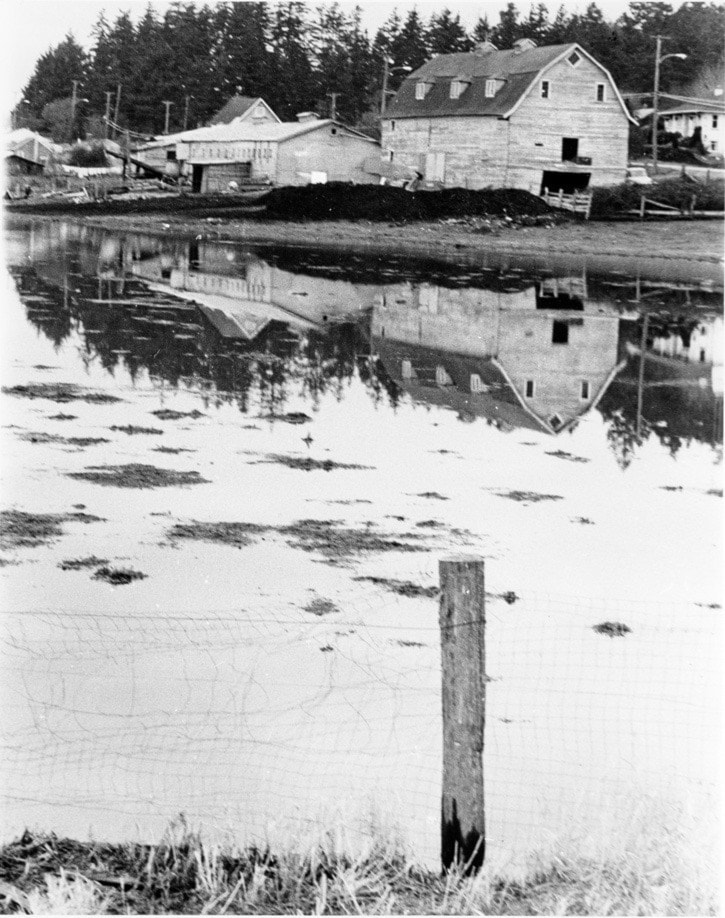It’s been more than 40 years since a teenaged Frank Leonard moved to Saanich from Vernon, where in the winter he could step out the door and skate on his front lawn.
“When we moved here I thought those days were behind me. But from time to time there’d be a bad winter – bad by Victoria terms – so Panama Flats would flood and freeze and turn into an ice rink,” the mayor said, recalling his earliest memories of the Colquitz River floodplain. “We’d put on our skates, on the side of the bank, and walk out. The water would be spread wide, but not deep … and away we’d go.”
Last week, council approved the $2.4-million purchase of the 62-acre (25 hectare) property from Island Berry Company Ltd.
“The importance of it is a lot of the land we consider to be part of the floodplain is private property. And they (Island Berry) consider it property that could be actively farmed, and that’s a significant dispute,” Leonard said.
In the winter, the Colquitz River typically breaches its banks and fills part of Panama Flats.
By owning the land, Saanich will be better able to moderate water flows and reduce flooding risks in the area, Leonard said.
The municipality and council can justify the purchase because of “the uniqueness of the property for its Colquitz River and floodplain infrastructure,” he added.
It also avoids going through a potentially costly court process as Saanich had sought an injunction to stop Island Berry from dumping fill on the site to build a berm that would prevent rising Colquitz waters from reaching the floodplain.
Marlene Todd, vice-president of the Strawberry Vale Community Association, had no comment on the purchase.
Former Saanich councillor Irene Block (served 1978-1990), who lives steps from Panama Flats, says this is a win-win situation for her community.
“I’ve had to come down here and look at flooded properties and seen flat-bottom boats on Interurban Road,” she said. “We need that 62 acres of floodplain. People don’t realize the value of things like that … but they see it when their basements are being flooded.”
Island Berry purchased Panama Flats in 2008 for $1.8 million from Vantreight Farms.
The deal with Saanich includes $910,000 cash from municipal reserves and two plots of land for residential development. The money comes from storm water, parks and right-of-way reserves.
Leonard said council didn’t look at purchasing the property in 2008 because “it didn’t come on our radar as a possible acquisition.”
“It had been farmed for many years without being an issue to ourselves and our residents … but changing the type of crop, and therefore requiring fill and berming, that’s when it came to our attention,” he said.
Leonard could not comment on what has been spent by the municipality in legal costs, as the sale is still being finalized.
In the 25 years Leonard has been on council, he says the significance of this deal rivals Saanich’s acquisition of Rithet’s Bog in the mid-1990s, under then Mayor Murray Coell.
“I don’t think many people remember what Rithet’s Bog looked like when we acquired it. It wasn’t a natural habitat, it was a farmed site. Today it’s a beautiful, natural protected area,” he said.
Wayne Hopkins, co-owner of Island Berry, said the company feels the lands are “better served with public stewardship.”
“When we sat down and weighed all the benefits for the community that Saanich was talking about, the potential they could do with the property versus what we were doing, we just figured it was the right thing to do,” he said.
He acknowledged some problems that arose after purchasing the property, in terms of the lands and neighbourhood mindset, that played a role in the decision to sell Panama Flats.
“If we would’ve known how difficult agriculture could be (in Panama Flats) we may have rethought (buying it),” Hopkins said.
Farming has thrived on the property for decades. Ian Vantreight purchased the property in 1979 and, until 2008, grew vegetables and daffodils in Panama Flats. Prior to that, it was owned by the Edge family, which ran a dairy farm there.
“It’s excellent farmland if the drainage issue could be resolved, and that’s always been the issue at hand,” Vantreight said.
The next steps will involve closing the deal and preparing the land for the coming winter. Following that, the municipality will begin community consultation to hear what the public thinks should be done with Panama Flats.
Leonard anticipates discussions around natural parks and food security.
“Should it be allotment gardens? Or is food security better achieved through leases to commercial farmers?” he asked.
The mayor would also like to see more of the property added to the Agricultural Land Reserve. Currently, about one-third is protected as ALR.
“I hope that, looking ahead 20 years, people won’t remember what Panama Flats looks like today,” Leonard said.
kslavin@saanichnews.com
What’s in a name?
• How did a plot of Saanich land earn a nickname derived from a Central American country?
• In the early 1900s, an engineer – only known in records as McDonald – purchased 1,200 hectares of land in Saanich using $100,000 he earned while working on the Panama Canal.
McDonald dubbed a swampy, flood-susceptible patch of his land “Panama Flats” because it reminded him of “the steamy jungles of Central America.”
– Courtesy Saanich Archives
